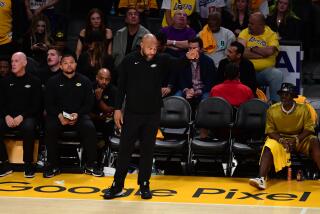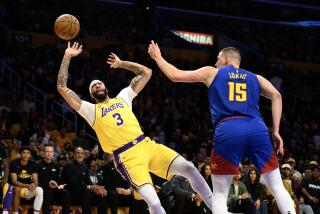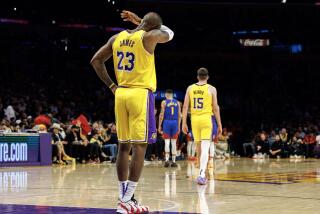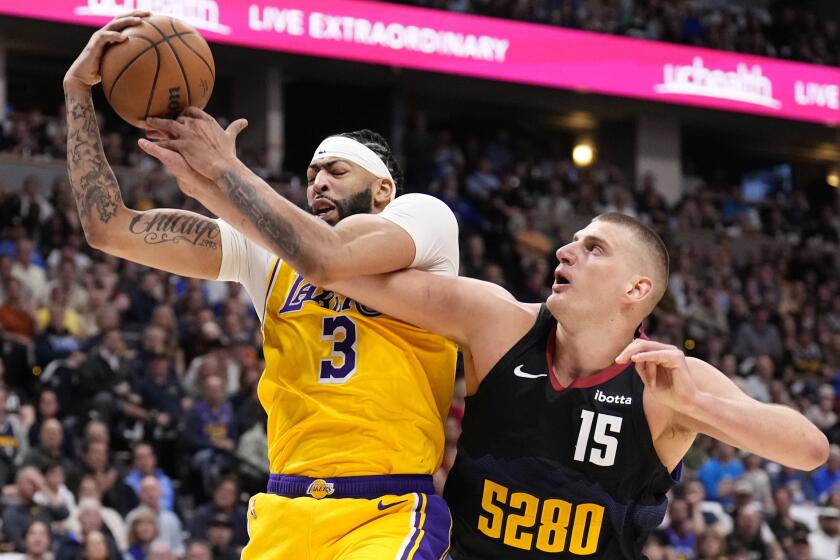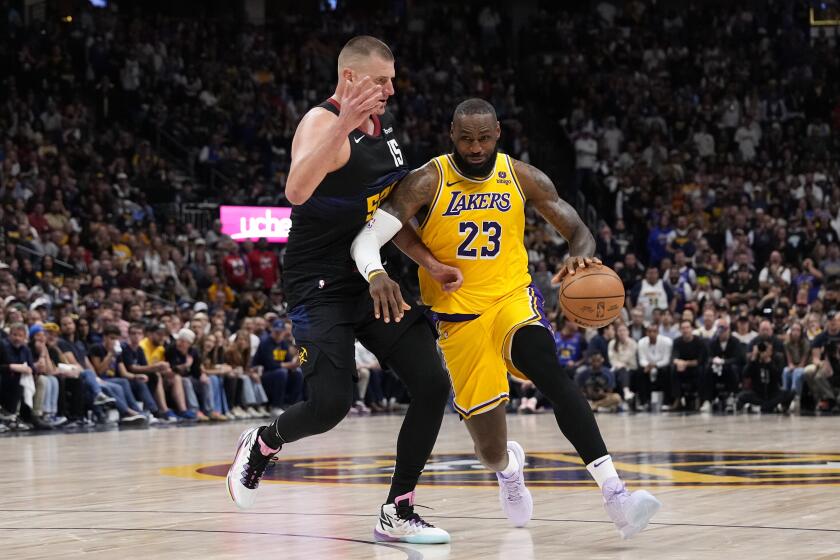A New Sunrise
If it’s spring, the Suns must be rising from their ashes once more, like the mythological bird this city was named for.
Of course, even the bird didn’t have to do it annually, much less monthly.
Yes, the Suns are back although no one (ever) believes it, because they’re still too small, don’t play defense, and, of course, Can’t Win That Way in the Playoffs.
Even so, they won 62 games last season, reached the Western Conference finals, swapped out half the franchise, ran away with the Pacific Division again and may be headed for a first-round matchup with the Lakers.
Not that the Lakers would be looking forward to it. The last time they beat the Suns, Shaquille O’Neal started at center. Since he left, the Lakers are 0-7.
No matter which version, the Suns’ offense is in a league of its own. No. 2 Seattle is six points behind their 108.5 a game. No. 2 Golden State is 2.2 three-pointers behind the 10 a game the Suns make.
After losing to them twice, by a total of 27 points, Miami Coach Pat Riley announced, “I don’t have a game [plan] for them, not this team.... I tried to make one, believe me.”
The Suns have done it the same way, just without some key people
Amare Stoudemire has been sidelined for all but three games. His replacement, Kurt Thomas, is on crutches, hoping to be back for the West finals, assuming, of course, they reach them.
Two of last season’s starters, Joe Johnson and Quentin Richardson, are gone, along with current Lakers Jim Jackson and Smush Parker, not to mention Yuta Tabuse, the NBA’s first Japanese player, executive of the year Bryan Colangelo and America West Arena.
Actually, the arena is still here but is now US Airways Arena. This isn’t part of the general housecleaning, but the result of airlines merging.
Nevertheless, by March 15, the Suns, who had started 4-5, were 45-19, having averaged 112 points since Jan. 1 while awaiting Stoudemire’s return from knee surgery, after which everyone else was really going to be in trouble ...
However, the comeback ended almost as soon as it began. Stoudemire underwent an arthroscopic procedure on his other knee last week. Pretending they weren’t really counting on him, the Suns announced he wouldn’t return this season.
“When you don’t have something and you play really well even though he hasn’t been here -- we’re fine,” Coach Mike D’Antoni said. “It’s not like we struggled to get to the playoffs and we’re struggling to play and oh, now he can’t play.
“We’re pretty confident of who we are and how we’ve done against teams without Amare.”
They use “pretty” a lot. Owner Robert Sarver said he was “still pretty optimistic.”
Of course, when you have overcome what they have, there’s a pretty good chance this may not be over yet.
Fathers, Sons
and Interlopers
To show how fast things have been moving, three seasons ago, D’Antoni was an assistant on Frank Johnson’s staff, having gone 14-36 in his one stint as a coach in Denver.
Now D’Antoni is the Suns’ coach, general manager and executive vice president of basketball operations, and the reigning coach of the year.
“I kinda go home and look at my wife and we just start giggling a little bit,” he says in his West Virginia drawl. “That kinda sums it up.”
From their birth in 1968, the Suns were run by Jerry Colangelo. A University of Illinois point guard, he started as GM, was interim coach twice, acquired controlling interest after a drug scandal in the ‘80s and became a local political power, spearheading the construction of the arena that revitalized the sleepy downtown, leading the group that brought in baseball and got Bank One Ballpark put up a block from the arena.
A shrewd infighter, Colangelo was also a paterfamilias. His Suns were even more family-oriented than the Lakers, with former players all up and down their directory: Mark West, Dick Van Arsdale, Connie Hawkins, Neal Walk, Alvan Adams, John Shumate, Tom Chambers, Eddie Johnson, Cedric Ceballos. Faithful retainers such as Cotton Fitzsimmons had jobs for life and were as much family as Colangelo’s son, Bryan, who rose to become the GM.
The Diamondbacks’ 2001 World Series championship in their fourth season after a dramatic, Game 7 ninth-inning rally against the New York Yankees’ Mariano Rivera marked the peak of Jerry’s power. However, the team faded and with loans from Major League Baseball due and tens of millions committed to such players as Curt Schilling and Randy Johnson, Colangelo was ousted by his partners.
In the summer of 2004, with the Suns rebuilding yet again, Colangelo sold the team to Sarver, an energetic banking magnate, cashing out for an NBA-record price, $401 million. Sarver gave Jerry Colangelo three seasons of operational control and Bryan a new contract as GM to ease the transition.
Control, which was supposed to be shared, passed quickly to Sarver, who wrote the checks. However, for his first season, his visibility was limited to courtside antics, such as wearing a chicken suit and, another time, flapping his arms like a chicken when the San Antonio Spurs sat out a gimpy Tim Duncan.
(Showing that the Spurs had noticed, when the Suns sat Steve Nash in San Antonio this season, Coach Gregg Popovich greeted D’Antoni by flapping his arms.)
Coming off a 29-53 season, en route to 62-20 with the newly acquired Nash, Sarver’s first season was a dream. His first off-season, though, was a disaster. Johnson left as a free agent and the local press laid it at the feet of Sarver, who had refused to OK a $50-million extension the preceding summer.
Everything spiraled downward, capped by the loss of Stoudemire in camp. The team was in the midst of shocking the world anew when Sarver turned down an extension for Bryan Colangelo, and the Toronto Raptors, in the midst of their own managerial chaos, stepped up with a $5 million-a-year offer.
Bryan left, telling local writers, “For the purpose of clarity, contrary to opinions stated, I was not anxious to leave nor was I given any concrete reason to stay.”
The opinions, of course, were stated by Sarver, who says he didn’t want to redo a contract he had done 18 months before, having already given Bryan “a significant raise” and, for the first time, a piece of the club.
“Bryan was under contract with us and he chose to pursue the opportunity in Toronto,” Sarver said. “It was really his decision.”
With the organization so closely tied to the family, everyone waited for Jerry’s reaction but he took it as a business matter. Due a seven-figure salary as chief executive through the end of next season, he expects to serve out his term.
“My preference would have been that Bryan would have been here for many, many years,” Jerry said. “But the way I look at it, professionally, if there’s any thought that he’s under my umbrella, that’s over. He’s respected by his peers. He was sought by Toronto and they had a one-man list. I think it’s the best thing that could have happened to him professionally....
“When you’re accustomed to making all the calls and it’s not that way anymore, it’s a little uncomfortable but under the circumstances, we’ve dealt with it. If I ever got to the point where I felt totally uncomfortable, I’d walk away.”
With Sarver exerting more control, the extension request might have been a way to explore Bryan’s future in the organization. It wasn’t what the Colangelos were hoping for but it was an answer.
The Newspaper
Boy as MVP
Happily for Sarver, he had a good alternative, promoting the easygoing, universally liked D’Antoni, who was a part of the old deal, to run the new deal.
“Any change of ownership, there’s going to be some turmoil and Robert has a way that he wants to do things,” D’Antoni said. “And Toronto comes out of the woodwork....
“The reason I got promoted was, and the reason we are where we are, the ball was going in the right direction. We wanted to keep it going that way and not bring somebody in that would have to put their stamp on everything....
“So it’s kind of a weird situation. Most of the time this happens when the team is in flux, so you would change things, get new players and build an organization. Well, this organization was going good and so Robert just wanted to keep the ball rolling.”
A year after Bryan Colangelo and D’Antoni were executive and coach of the year and Nash the most valuable player, it is generally conceded that all three have surpassed themselves this season.
Amazingly enough, with Nash coming off one MVP season and sure to run strongly in the voting for a second, it still seems as if few understand how good he really is.
Or as Clipper Coach Mike Dunleavy said, “If he doesn’t win the second MVP, then people don’t know how good he is.”
The Suns open the middle and run Nash off pick-and-rolls to take what the defense gives up, whether he shoots over the top, drives and finds open teammates or puts the ball up himself. As Clipper assistant Jim Eyen noted while going over the defensive game plan last week, other point guards do those things but only Nash does them all.
He does them so well, the Suns can make it work with anyone who can handle the ball and shoot it.
Everyone now loves Boris Diaw, a 6-foot-8 guard who has invented the new positions of point-power forward and point-center, but when he arrived from Atlanta as a throw-in in the trade for Johnson, he was a bust.
“A lot of people liked him as a backup point and they liked him as this and liked him as that,” D’Antoni said. “I liked his talent but, gosh, he’s 6-8 or 6-9 with his [lack of] speed and the way we wanted to play, we’re not going to walk it up, we’re not going to pound it in.... My first thought was, ‘Gosh, is he really going to help us?’
“It was what can we get? It’s not like, ‘OK, let’s trade Joe and get that guy.’ ”
So it’s another eye-opener, all the way around.
“We’re a very small team so there’s going to be a lot of people who don’t believe in us, and rightfully so,” Nash said. “No team, I think, as small as us has ever won. But that’s fine.”
No team as small as they may ever win, but if one ever is going to, their chances are pretty good.
*
(BEGIN TEXT OF INFOBOX)
Basket cases
Phoenix is the Pacific Division champion for a second season in a row because it leads the NBA in scoring at 108.5 points a game and three-point shooting at 39.4% (through Tuesday):
*--* SCORING Team Own Opp. FG Pct. Phoenix 108.5 103.0 47.9 Seattle 102.4 105.8 45.7 Washington 101.6 100.1 44.7 Toronto 101.1 103.6 45.6 Denver 101.0 100.1 46.3 Miami 100.2 95.9 48.0 Philadelphia 99.6 101.6 45.8 Dallas 99.3 92.6 46.4 LAKERS 99.0 97.0 45.2 Sacramento 98.7 97.6 45.4
*--*
*--* THREE-POINT SHOOTING Team Own Opp. Made Phoenix 39.4 36.8 772 Detroit 38.6 32.3 527 Milwaukee 38.2 35.5 470 San Antonio 38.0 34.1 485 Dallas 37.7 35.6 399 Chicago 37.5 35.0 520 Orlando 37.3 35.8 276 Toronto 37.3 37.3 579 Philadelphia 36.9 35.5 351 Atlanta 36.8 36.7 391
*--*
More to Read
All things Lakers, all the time.
Get all the Lakers news you need in Dan Woike's weekly newsletter.
You may occasionally receive promotional content from the Los Angeles Times.
